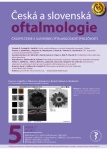SPONTANEOUS REGRESSION OF A PRIMARY IRIS STROMAL CYST IN A PATIENT WITH KERATOCONUS. A CASE REPORT
Autoři:
V. Galvis 1,2,3; CL. Shields 4; A. Tello 1,2,3; CA. Niño 1,2,3; AN. Laiton 2,3; JD. García 1,5; TA. Chaparro 1,2; EJ. Viteri 2,3
Působiště autorů:
Centro Oftalmológico Virgilio Galvis, Floridablanca, Colombia
1; Fundación Oftalmológica de Santander FOSCAL, Floridablanca, Colombia
2; Universidad Autónoma de Bucaramanga UNAB, Bucaramanga, Colombia
3; Ocular Oncology Service, Suite 1440, Wills Eye Hospital, 840, Walnut St, Philadelphia, PA 19107, USA
4; Universidad de la Sabana, Chía, Colombia
5
Vyšlo v časopise:
Čes. a slov. Oftal., 77, 2021, No. 5, p. 253-256
Kategorie:
Kazuistika
doi:
https://doi.org/10.31348/2021/28
Souhrn
Purpose: To report the rare case of a 29-year-old male with a history of keratoconus, who presented with a primary iris stromal cyst which eventually showed spontaneous regression.
Methods: Description of the clinical findings in the case of a 29-year-old male with a prior history of keratoconus, but no eye surgery or trauma, who consulted for an iris cyst in the left eye, diagnosed 9 months earlier.
Case report: Slit-lamp examination revealed mild dyscoria, and a large cyst in the inferior quadrant of the iris. Ultrasound biomicroscopy and anterior segment optical coherence tomography of the left eye confirmed the presence of a giant iris cyst with thin walls, in contact with the corneal endothelium. Corneal endothelial cell density in the inferior cornea (close to the cyst) was 1805 cells/mm2 and 2066 cells/mm2 in the central area. After considering the risk of anterior chamber epithelial downgrowth following any surgical procedure of the cyst, the patient received conservative management. In the following months, the patient presented with 3 episodes of anterior uveitis, managed with topical corticosteroids. Finally, at approx. 21 months after the initial diagnosis, the cyst presented spontaneous regression. Anterior segment optical coherence tomography confirmed the absence of fluid inside the cyst remnants and the final endothelial cell densities evidenced endothelial cell loss (inferior cornea 738 cells/mm2 and central cornea 1605 cells/mm2).
Conclusion: Conservative management should be considered in patients with cysts that show slow progression and are distant from the visual axis, in order to minimise the risk of complications following any surgical procedure of the cyst. In addition, the present case is one of the few of primary stromal iris cysts with spontaneous regression reported in the literature.
Klíčová slova:
iris cysts – iris diseases – iris stromal cyst management – keratoconus
Zdroje
1. Lois N, Shields CL, Shields JA, Mercado G, De Potter P. Primary iris stromal cysts. A report of 17 cases. Ophthalmology. 1998 Jul;105(7): p. 1317-1322.
2. Shields CL, Arepalli S, Lally EB, Lally SE, Shields JA. Iris stromal cyst management with absolute alcohol-induced sclerosis in 16 patients. JAMA Ophthalmol. 2014 Apr;132(6): p. 703-708.
3. Orlin SE, Raber IM, Laibson PR, Shields CL, Brucker AJ. Epithelial downgrowth following the removal of iris inclusion cysts. Ophthalmic Surg. 1991 Jun;22(6): p. 330-335.
4. Winthrop SR, Smith RE. Spontaneous regression of an anterior chamber cyst: a case report. Ann Ophthalmol. 1981 Apr;13(4): p. 431-432.
5. Brent GJ, Meisler DM, Krishna R, Baerveldt G. Spontaneous collapse of primary acquired iris stromal cysts. Am J Ophthalmol. 1996 Dec;122(6): p. 886-887.
Štítky
OftalmologieČlánek vyšel v časopise
Česká a slovenská oftalmologie

2021 Číslo 5
- Stillova choroba: vzácné a závažné systémové onemocnění
- Diagnostický algoritmus při podezření na syndrom periodické horečky
- Oční vyšetření a možnosti léčby v ordinaci praktického lékaře
- Kontaktní dermatitida očních víček
- Familiární středomořská horečka
Nejčtenější v tomto čísle
- VYUŽITÍ UMĚLÉ INTELIGENCE V ZÁCHYTU DIABETICKÉ RETINOPATIE. PŘEHLED
- OBOUSTRANNÁ AMYLOIDÓZA TŘÍ VÍČEK. KAZUISTIKA
- MODROŽLUTÁ PERIMETRIE U PACIENTŮ S DIABETEM BEZ DIABETICKÉ RETINOPATIE
- Prof. MUDr. Anton Gerinec, CSc. – ENCYKLOPÉDIA OFTALMOLÓGIE
